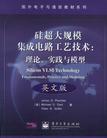硅超大规模集成电路工艺技术
2003-4-1
电子工业出版社
Michael D.Deal,Peter B.Griffin,James D.Plummer
817
无
《硅超大规模集成电路工艺技术:理论、实践与模型》是美国斯坦福大学电气工程系“硅超大规模集成电路制造工艺”课程所使用的教材,该课程是为电气工程系微电子学专业的四年级本科生及一年级研究生开设的一门专业课。《硅超大规模集成电路工艺技术:理论、实践与模型》最大的特点是,不仅详细介绍了与硅超大规模集成电路芯片生产制造相关的实际工艺技术,而且还着得讲解了这些工艺技术背后的科学工艺过程的物理图像。同时全书还对每一步单项工艺技术所要用到的测量方法后面都附有相关内容的参考文献,同时还附有大量习题。 对于我国高等院校微电子学专业的教师及学生,《硅超大规模集成电路工艺技术:理论、实践与模型》是一本不可多得的优秀教材和教学参考书,并可供相关领域的工程技术人员学习参考。
James D.Plummer:于美国斯坦福大学获得电气工程博士学位。目前是斯坦福大学电气工程系教授。Plummer博士已撰写或与人合作撰写了300多篇技术论文,并于1991年获得了电化学协会颁发的“固态科学与技术奖”。1996年,他被选入美国国家工程院。目前致力于硅设备与技术方面的研究。
第1章 引言及历史展望第2章 现代CMOS工艺技术第3章 晶体生长、晶圆片制造及硅晶圆片的基本特性第4章 半导体生产——洁净室、晶圆片清洗与吸杂第5章 光刻第6章 热氧化主硅/二氧化硅界面第7章 杂质扩散第8章 离子注入第9章 薄膜淀积第10章 刻蚀第11章 后道工艺技术附录索引
Silicon is unique among semiconductor materials in that its surface can be easily passivated with an oxide layer. The interface between Si and SiO2 is perhaps the most care-fully studied of all material interfaces and its electrical and mechanical properties as well as those of the oxide layer itself are almost ideal. SiOe layers are easily grown thermally on silicon or deposited on many substrates. They adhere well, they block the diffusion odorants and many other unwanted impurities, they are resistant to most of the chemicals used in silicon processing and yet can be easily patterned and etched with specific chemicals or dry etched with plasmas, they are excellent insulators, and they have stable and reproducible bulk properties, The interface that forms between Si and SiO2 has very few mechanical or electrical defects and is stable over time. These properties make MOS structures easy to build in silicon and they imply that silicon devices of all types are generally reliable and stable. Virtually all other semiconductor/insulator combinations suffer from one or more problems that significantly limit their applicability. We saw a number of applications of SiO2 layers in the CMOS technology example in Chapter 2. These included use as the gate dielectric layer in MOS devices, as a mask against implantation, as an isolation region laterally between adjacent devices, and as an insulator between metal layers in back-end processing. These and some other uses are illustrated in Figure 6-1. The SLA NTRS provides a roadmap for SiO2 and other insulating layers as part of its general technology requirements, Some of the key issues are summarized in Table 6-1[6.1]. Most of these requirements relate to oxides < 10 um since these are the critical gate insulators and tunneling oxides in modern MOS structures The last two rows in the table relate to thicker insulators used primarily for masking and in back-end processing. These insulating layers are normally deposited rather than thermally grown and will be discussed in more detail in Chapters 9 and 11. Even at room temperature, silicon exposed to an oxygen or air ambient will form a thin native oxide layer on its surface. This oxide rapidly covers the surface to a thickness of 0.5-1 um (5-10 A). Growth then slows down and effectively stops after a few hours, with a final thickness on the order of 1-2 nm. Both the growth rate and the final native oxide thickness depend on the surface preparation and in particular on the presence or absence of chemical residues from cleaning procedures` For example, the SC-1 and SC-2cleaning procedures we discussed in Chapter 4 create chemical oxides on the silicon surface which are typically 1-2 um thick.
《硅超大规模集成电路工艺技术:理论、实践与模型》是美国斯坦福大学电气工程系“硅超大规模集成电路制造工艺”课程所使用的教材,该课程是为电气工程系微电子学专业的四年级本科生及一年级研究生开设的一门专业课。《硅超大规模集成电路工艺技术:理论、实践与模型》最大的特点是,不仅详细介绍了与硅超大规模集成电路芯片生产制造相关的实际工艺技术,而且还着重讲解了这些工艺技术背后的科学原理。特别是对于每一步单项工艺技术,书中都通过工艺模型和工艺模拟软件,非常形象直观地给出了实际工艺过程的物理图像。同时全书还对每一步单项工艺技术所要用到的测量方法做了详细的介绍,对于工艺技术与工艺模型的未来发展趋势也做了必要的分析讨论。另外,《硅超大规模集成电路工艺技术:理论、实践与模型》每一章后面都附有相关内容的参考文献,同时还附有大量习题。

无